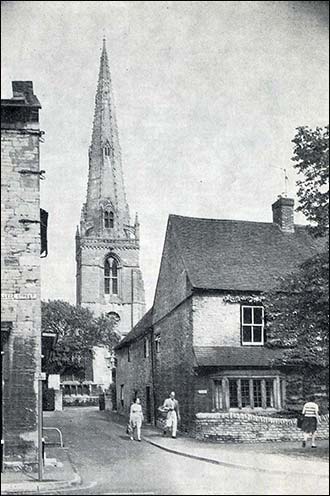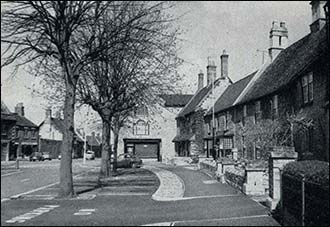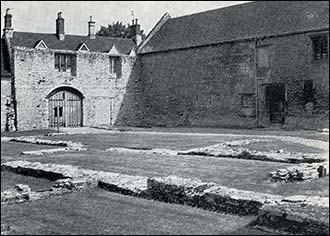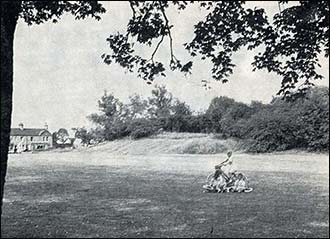|
|
|
Church Walk from Market Square, Higham Ferrers
Photo by A. J. George
|
|
|
|
|
|
East Side of Market Square
Photo by Stanley Cutmore
|
|
|
|
|
|
Grounds of Chichele College
Photo by A. J. George
|
|
|
|
|
|
Castle Field, Higham Ferrers
Photo by A. J. George
|
|
|
The heart of old Higham Ferrers centres round the magnificent church, together with Archbishop Chichele’s Chantry School and Bede House. The main thoroughfare, with its limestone houses, is of beauty, but the traveller must turn aside to see the real greatness of Higham. A lane between the shops leads one to the church, a wonderful building that shares a common plot with the Chantry and the Bede House, the three buildings forming a close as lovely, quiet and unspoilt as that of a cathedral town.
The Parish Church, one of the most beautiful in the Midlands, has a richly crocketed steeple which, with its pierced parapet, flying buttresses and deep mouldings, soars to 170 feet above the buildings clustered around. The spire surmounts a 13th century west tower whose doorway is carved in a manner not unlike that of Westminster Abbey, work executed in or around the year 1260. In 1631 the spire and part of the tower collapsed and was immediately re-built with extra buttresses added. The recessed double west door has a fine and intact series of sculptured roundels of the life of Christ.
The church has, in fact, a double nave and is thus as spacious as a small cathedral. The south side is 13th century in construction whilst on the north side all is of the 14th century. The proportions of the buildings are fine and the various chapels, screens and arches add an intimacy to the grandeur of the scene. There is to be found much good carved woodwork both old and new, the more modern work being by Comper. Some of the older woodwork was given by Archbishop Chichele at the time when he founded his college. He gave some of the church screens and twenty miserere seats in the chancel, seats that are carved with human heads, birds, animals, angels and more grotesque figures.
Many other features in this wonderful building are of interest. Oldest of the memorials is a canopied altar tomb whose brass commemorates a rector who died in 1337. In the Lady Chapel are several brasses including one to Thomas and Agnes, parents of Chichele. Two effigies commemorate the Archbishop’s brother William (a sheriff of London who died in 1425) and his wife, while Chichele himself is remembered in the East window of the Lady Chapel. One of the other brasses commemorates Richard Wylleys, who was, in the early 16th century, warden of the Archbishop’s college. The bellringing chamber with its wrought iron balcony and the inner porch doors portraying the Annunciation in glass, by John Hayward, was given by John White in 1969 as a memorial to his wife.
At the west end of the church and separate from it is the Chantry Chapel. A small and beautiful place, it was founded by Chichele rather later than the Bede House and, after the Dissolution it continued as a grammar school for nearly three centuries. Today it serves as a chapel for occasional services. With its tall crocketed pinnacles and carved battlements externally and internally with its undercut mouldings and large windows that reduce wall surface to a minimum, it is a gem of Perpendicular architecture. The wooden porch has the date 1636 inscribed on its rather blackened framework, together with interesting schoolboy carvings of the 17th century.
Forming the third of the lovely churchyard group is the Bede House, which was founded in 1423 by Chichele to house twelve poor men and a woman attendant. The building, of layers of light and dark stone, today serves as a Parish Hall in constant use by local societies and the centre of local arts organisations. The impressive timber roof and the large open fireplace are original 15th century features and some of the lockers used by the early ‘poor men’ still survive. Although the Bede House has long since ceased to be used for its intended purpose, the town still elects Bedesmen, and a bedeswoman prepares meals for them in the bedehouse on St Thomas’ Day when a church service is also held for them.
A final feature of interest in the churchyard is the Old Cross which dates back to the 14th century. It was restored to serve as a Memorial to those who fell in the First World War.
In 1422 Archbishop Chichele founded a college on the west side of Higham Ferrers church, some fifteen years before he had All Souls College, Oxford, built. The Higham College was built around a quadrangle which housed twenty members, consisting of eight chaplains, four clerks, six choristers and a song and grammar master. The college was dissolved by Henry VIII and the buildings were in ruins by the 18th century. The main surviving fragment of the fabric is the gabled front with its Tudor door and windows with square hood moulding. Above the door are empty niches that once held statues of the college’s patron saints. Although these ruins have been used for various purposes they were transferred to the Ministry of Works in 1948 by King George VI and are now preserved as an ancient monument. The Town Council look after the gardens, and the grounds (the former quadrangle) are open to the public. When the Warden and Fellows of All Souls, Oxford, came to Higham to celebrate the quincentenary of Chichele’s college and, as a gesture of the link between the town and Oxford, they purchased and carefully restored a stone house in the High Street. This building is said to have been Chichele’s birthplace, although there are no detailed records to prove this.
Other old houses in the centre of Higham are numerous and their common building material – local limestone – gives them an attractive uniformity. Opposite the college ruins is College House, a handsome and extensive building erected in 1633 and formerly owned by All Souls College. Its two gabled bays and its square headed windows are typical of the period in which the house was built. On the corner of Wood Street is the Manor House with numerous Elizabethan features, whilst the nearby Green Dragon Hotel is of interest for the medieval dove cote to be found in its garden.
In the centre of the wide main street is the Town Hall, a small and curiously boxlike little building that dates from 1808. On its wall may be seen carved the borough seal, whilst inside, the room once used as a lock-up has in recent years been removed when the building was restored and the Council Chamber renovated. Facing the Town Hall is the memorial to those who fell in the Two Wars and a little further along the road is the 13th century Market Cross. Its age is uncertain but it certainly dates from the medieval years when the market was held around it. The market Square is now used as a Car Park and a further large Car and Lorry Park is available close by in Saffron Road.
In College Street are an attractive group of Alms-Houses built in 1865 and restored in recent years. At the North End is an ancient walnut tree and opposite the College a pear tree that was shown in a print of the same spot in 1838. The latter tree is still cropping.
The chief open space in the town is the Sports Ground which stands close to the college ruins and also reached from Wharf Road (which leads down to the Nene and was much used to transport local products). Of interest in part of the sports ground is the Saffron Moat, the old fishing pond used by the college occupants. The ground has extensive areas of grass, a children’s corner and facilities for tennis, bowls, cricket and football. Also here is a well-equipped modern sports pavilion. Other open spaces are at the Castle Field, the College grounds and play spaces on the housing estates.



